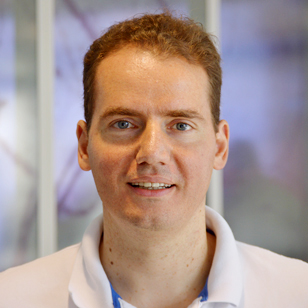Inside IU Professor Eleftherios Garyfallidis' quest to unlock the brain's secrets.

Eleftherios Garyfallidis witnessed the devastating impact of mental illness firsthand as an undergraduate student in Athens, Greece. Waiting in a psychiatrist's office to meet with a doctor for a research project, Garyfallidis observed a father and son, both grappling with schizophrenia, their frustration and stress palpable.
That moment set the course for Garyfallidis' future, igniting a passion to unravel the mysteries of the human brain.
“I felt like people like me who are healthy and have the ability to learn and solve problems should look into this,” Garyfallidis says, recalling that pivotal moment.
Today, as an associate professor of intelligent systems engineering at Indiana University’s Luddy School of Informatics, Computing, and Engineering, Garyfallidis is doing just that as he finds himself at the forefront of a revolution in brain imaging and analysis.
From Athens to Bloomington
Garyfallidis’ path to becoming a pioneer in neuroimaging was molded by his diverse academic background. After completing his undergraduate studies in Greece, he pursued a PhD at the University of Cambridge in the United Kingdom. It was there that the seeds of his groundbreaking work were planted.
While doing early research in computational neuroscience, he became interested in how to non-invasively study the brain. MRI, particularly diffusion MRI, caught his attention because it provided unique insights into brain structure and connectivity.
That interest led him to postdoctoral work at the University of Sherbrooke in Canada, where he honed his skills in diffusion MRI analysis. In 2016, Garyfallidis joined Indiana University, attracted by Luddy’s emphasis on interdisciplinary research and innovation.
Google Maps for the brain
At the heart of Garyfallidis’ work is DIPY – Diffusion Imaging in Python — an open-source software he created that has become a game-changer in the field of neuroimaging. Garyfallidis describes DIPY as a powerful toolkit that helps scientists see and understand how the brain is wired.

Think of it like Google Maps for the brain. It helps researchers track pathways, detect abnormalities, and better understand how different regions of the brain communicate.
Eleftherios Garyfallidis
This innovative tool has far-reaching implications, particularly in studying neurological conditions such as Alzheimer’s, multiple sclerosis, and traumatic brain injuries. By providing researchers with a unified and flexible framework for analyzing diffusion MRI data, DIPY has democratized access to cutting-edge brain imaging techniques.
The impact of DIPY has been profound. What started as a project in 2010 has grown into a global phenomenon, with more than 200 contributing scientists and countless users worldwide.
Garyfallidis says he is proud to be a part of the origin story of this new global community populated by those dedicated to helping others. Seeing researchers, engineers, and clinicians from around the world take this tool he created and extend its capabilities has been one of the most rewarding parts of his career, he says.
Bridging disciplines for breakthrough discoveries
Garyfallidis’ work exemplifies the Luddy mission of creating tomorrow today. His research combines medical imaging, artificial intelligence, and engineering visualization – a package that holds immense potential for advancing our understanding of the brain and improving healthcare.
This intersection captivates Garyfallidis because it allows researchers to extract meaningful insights from vast amounts of data, Garyfallidis says. For example:
- Machine learning helps them find patterns that might otherwise go unnoticed.
- Medical imaging provides a window into the structure and function of the brain.
- Engineering visualization turns these complex datasets into something interpretable and actionable.
The collaborative environment at IU has been crucial to Garyfallidis’ success. It allows him to work with experts in neuroscience, optometry, computer science, and medicine, providing the collective brain power and innovation skills to tackle complex problems from multiple angles, he says.
It also has led to groundbreaking projects, including recent work in oculomics — using the eye as a window into overall health. This project, supported by a $4.8 million NIH grant, aims to develop non-invasive eye tests for early detection of conditions such as Alzheimer’s disease, diabetes, and heart disease.
Creating tomorrow today
As Garyfallidis looks to the future, he sees enormous potential for AI to advance our understanding of the brain. However, he cautions against common misconceptions about the technology.
AI is not merely the latest and greatest computer tool, he says. This is the field of science that works to create computational brains that far outpace human intelligence as a whole. Leading the path to superintelligence. What is surprising is that such computational brains are so far purely mathematical and therefore the entire field of AI has an incredibly strong requirement in mathematics. It seems Plato was right saying that non-physical (mathematical) forms are the basis of reality. A recurring theme in AI which is now being able to learn physics from watching videos.
That perspective drives Garyfallidis’ approach to teaching and research. He strives to inspire students to think critically and creatively, emphasizing hands-on experience with building AI algorithms from the ground up. His goal is to prepare the next generation of researchers to tackle the complex challenges of brain science.
As he continues to push the boundaries of neuroimaging and AI, Garyfallidis remains committed to the open source principles that have defined his career.

Whether in neuroimaging, machine learning, or medical technology, the best progress happens when knowledge is shared, tools are accessible, and researchers work together across disciplines. That's what drives my work, and I hope to continue pushing these efforts forward.
Eleftherios Garyfallidis
In the end, Garyfallidis' work is about more than just advancing technology. It is about improving lives.
From that moment in an Athens psychiatrist’s office to his lab at IU, his mission remains the same: to unlock the secrets of the brain and pave the way for better treatments and understanding of neurological disorders.
“People dream about self-driving cars navigating the streets of our cities,” he says. “I dream of self-driving algorithms that navigate the pathways of our brains and provide guidance for disease treatment and long-term prevention.”
